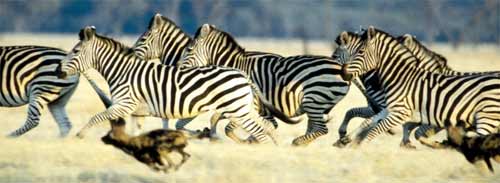|


Painted Wolves: The Latin name of the species means painted wolf and no two individuals have the same pattern of coat.
Their fur is an irregular pattern of black, yellow, and white. Some areas of the body are nearly hairless, and the skin is black.

Packs, Man: African wild dogs hunt in packs. Their main prey are impala and similar medium sized ungulates. They're known for their stamina and for being clever hunters; they have been observed hunting prey in relays, or even blocking a potential escape route for prey.
Family Values: Members of a hunting pack vocalize to help coordinate their movements. Their voice is characterized by an unusual chirping or squeaking sound, similar to a bird. After a hunt, dogs will often regurgitate meat for members of the group that have stayed behind, including the old, the lame, the pups, and subordinate adults who have taken on the responsibility of caring for the pups.

Dogs in Danger: Their need for a large territory has led to the situation where today they are threatened with extinction. Their relatively small physique also makes them vulnerable to attacks by their competitors, lions and hyenas. The dogs are also killed by livestock herders and game hunters. They tend to be elusive and unlike most other members of the dog family, are extremely difficult to tame.
The current estimate for remaining wild dogs in the wild is approximately 5,600. Of these, the majority live in the two remaining large populations associated with the Selous Game Reserve in Tanzania and the population centered in northern Botswana and eastern Namibia. Isolated populations persist in Zambia, Kenya, Mozambique, Zimbabwe and South Africa.
  All in the Family: They have a highly complex social system, within which related adult members cooperate to produce a single litter of pups annually. The breeding female occupies a den while she bears the pups, usually selecting an abandoned aardvark burrow for this purpose. All in the Family: They have a highly complex social system, within which related adult members cooperate to produce a single litter of pups annually. The breeding female occupies a den while she bears the pups, usually selecting an abandoned aardvark burrow for this purpose.
It's Rainin' Males: Most populations have more males than females because more male pups appear in litters. It is very unusual among mammals to have this kind of gender bias.
Females are more likely disperse from the natal group, and they readily join packs which have no sexually mature female members. In packs with more than one female, only one will be allowed to breed, leading to vicious rivalry between females.
All text is available under the terms
of the GNU Free Documentation License
|